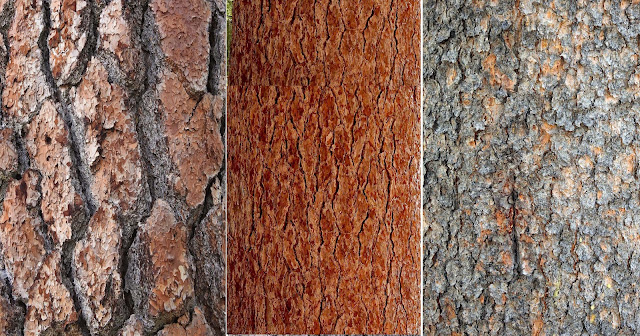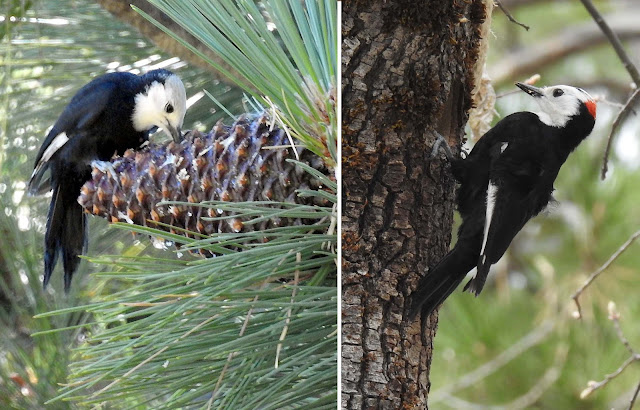Black-backed Woodpecker nest with a "plate" surrounding the nest hole
In the Lakes Basin, dead or diseased conifer trunks are the homes of several birds (mainly woodpeckers) and mammals. Nest holes are much easier to excavate in these types of trees, as the wood is much softer than a living tree. All woodpeckers are cavity nesters. They make their cavities in tree trunks, dead branches, stubs, or even stumps! Typically, woodpeckers excavate a new nest every year, and old nests are not reused. However, abandoned woodpecker nests are often inhabited by owls, chickadees, nuthatches, blue birds, Douglas Squirrels, Flying Squirrels, and sometimes even Pine Martens!
Black-backed Woodpecker (male) - Picoides arcticus
The nest hole in the first photo was created by Black-backed Woodpeckers. They will occasionally peel off the bark around the nest hole (creating a "plate"), which exposes the sticky sap beneath it. This exposed sap is a deterrent to predators, such as tree-climbing snakes. These woodpeckers usually build their nests in dead conifers, but sometimes nest in live ones.
White-headed Woodpecker (male) - Picoides albolarvatus
White-headed Woodpeckers usually nest in dead conifer trunks. They are also known to nest in dead stumps, as well as leaning or fallen logs.
Downy Woodpeckers usually nest in the trunks of dead conifers and deciduous trees, or the dead parts of live trees. Sometimes they will excavate a nest in a small stub that leans away from vertical, with the entrance hole to the nest on the underside of the stub.

Red- breasted Sapsucker - Sphyrapicus ruber
Red-breasted Sapsuckers nest in dead conifers or deciduous trees,
or in the dead parts of live trees.
The Northern Flicker is a woodpecker but has different behavior than most woodpeckers. They mainly forage on the ground, not on tree trunks, for ants and other insects by probing and hammering in the soil. They usually nest in dead or diseased tree trunks and large branches, preferring mainly aspens. Unlike other woodpeckers, flickers will reuse an old nest.
Red-breasted Nuthatch (male) at nest hole - Sitta canadensis
photo ©Mia McPherson of onthewingphotography.com
Much like woodpeckers, Red-breasted Nuthatches excavate their nests in dead trees. It takes a male and female pair, 18 days to chisel and hammer out a nest! They will sometimes reuse one of their old nests, or even an old woodpecker nest!
Brown Creeper (adult) at nest site - Certhia americana
photo ©Doug Backlund of wildphotosphotography.com
Tree Swallow (adult) - Tachycineta bicolor
Tree Swallows readily nest in old woodpecker nests,
as well as natural tree cavities.
Northern Flying Squirrel ©nature.ca/en/ - Glaucomys sabrinus
Northern Flying Squirrels will nest in tree hollows, abandoned woodpecker nests, and hollow stumps or limbs. They are strictly nocturnal and are rarely seen. 90%-100% of their diet is underground fungi and lichen! They don't truly "fly". They "glide" from trees and branches to the ground. I've never seen one of these beautiful little animals, but I would love to!
American Marten ©carnivora.net - Martes americana
American Martens can live in a tree hollow, rock den, fallen log, squirrel's nest or even a woodpecker's nest! They forage in the early morning, late afternoon, and at night, on the ground and up in the tree canopy. I've only seen an American Marten once in my lifetime! It was on the High Sierra Trail in Sequoia National Park, in the late afternoon. I was backpacking up to a lake, and as I came around a bend in the trail there was a lone American Marten in view! We locked eyes for just a few seconds and then it was gone, but I'll never forget it!
Douglas Squirrel or Chickaree - Tamiasciurus douglasii
In the summer, Douglas Squirrels will make a nest for their young out of mosses, lichens, twigs and shredded bark. In the winter an adult will live in a woodpecker hole or natural hole in a tree. American Martens are one of its main predators.
Western Gray Squirrel - Sciurus griseus
In the summer, Western Gray Squirrels make nests out of shredded bark and sticks, usually about 20' above the ground in a tree. In the winter, they probably live in natural tree cavities.
Wolf Lichen - Letharia vulpina
In my next blog I'll talk about the plants that live on tree trunks. Check back on 10/12/24 to learn about what lives in, and what eats, these plants!
un-named pond
Lakes Basin Update!
In the past month and a half, I've been able to hike in the Lakes Basin four times. Each time I hiked into a different area, and it was all fabulous! The pond pictured above was totally new to me, and we were there on a glorious, cloudy-blue-sky day! I feel so privileged to have been there! Such Beauty!!!
view to the northwest of Mt. Elwell
On the way to the pond we had beautiful views to the north and west!
Frog - Wax Currant - unknown galls on Tobacco Brush
Rana sp. - Ribes cereum - galls on Ceanothus velutinus
Sierra Tiger Beetle - The Sierra Buttes - Leathery Grapefern
Cicindela tranquebarica ssp. sierra- Septricium multifidum
Lower Salmon Lake
On another day, my husband and I hiked to Lower Salmon Lake. On the way we had a lovely view of the Sierra Buttes, ran into a few bright green Sierra Tiger Beetles, and found a patch of unusual Leathery Grapeferns!
Lower Salmon Lake
Long Lake from the Pacific Crest Trail - inset photo: Ospreys
Pandion haliaetus
Up on the Pacific Crest Trail (PCT)
My friend Nancy and I also hiked up to the PCT on a slightly smokey day about a month ago. At the ridge top, we lucked out and saw a pair of adult Ospreys flying overhead! In some areas there were thousands of ripening Bitter Cherries! We also saw several immature Mountain Bluebirds that day. Our time in the Lakes Basin is always treasured!
Immature Mountain Bluebirds - Bitter Cherries
Sialia currucoides - Prunus emarginata
Mt. Elwell
Part of the Round Lake Trail
On another day my husband and I walked out the Round Lake Trail about a mile and a half to a view of Mt. Elwell! It was another gorgeous cloud-filled day, and White-crowned Sparrows posed for us on the tops of bushes, while lofty Blue Elderberries beckoned!

White-crownes Sparrows (adults) - Elderberries
Zonotrichia leucophrys - Sambucus mexicana
We got about a tenth of an inch of rain last week! It came in two different downpours that lasted less than an hour each. Everything was refreshed and glistening! Hopefully more rain will come again soon!
Are there any fall colors happening?
What's happening in the river?
Check back in two weeks to find the answers to these questions and more!
After 8 years of posting my blog, I've decided that I'm only going to post my blog twice monthly from now on. My next post will be on the weekend of October 12th. See you then!
Your questions and comments are always appreciated. Please email me at northyubanaturalist@gmail.com. Thanks!










.jpg)


























